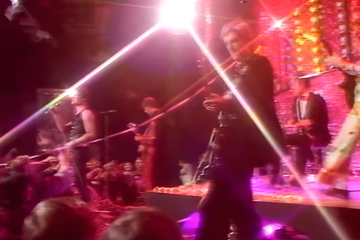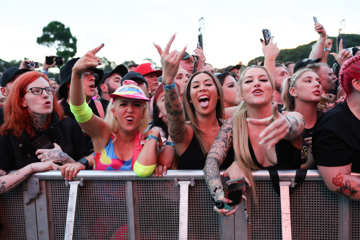James Blake Opens Up About Creative Blocks And Depression
"There were so many things in my life that weren't right and I needed to sort them all out..."

James Blake

James Blake may have emerged from the UK's electronic music underground, but today he's one of the game-changers in R&B and hip hop. Kanye West has declared Blake his favourite artist. And the avant-soul auteur contributed to Beyonce's Lemonade. But it hasn't all been rosy. Following 2013's Mercury Prize-winning Overgrown, Blake experienced a creative block induced by anxiety. His latest album, The Colour In Anything, is about him surmounting it.
Blake rarely gives interviews — conceivably, he stealth-released The Colour In Anything to minimise advance promo chores — but he's making an exception ahead of his return to Australia for Splendour In The Grass. When he does talk, Blake is as inscrutable as he is gracious. He speaks carefully, often offering an "Mmm." Nonetheless, Blake can be obliquely revealing.
The North Londoner was born James Blake Litherland, being named after his father — a member of the cult prog-rock band Colosseum. An only child enamoured of the piano, Blake attended music college. Meanwhile, he discovered clubs — and dubstep. Now a bedroom producer, he circulated 2009's Air & Lack Thereof. However, Blake, his sensibilities expansive, would transform into a new kind of post-dubstep balladeer on airing that otherworldly cover of Feist's Limit To Your Love. In 2011 Blake's eponymous debut, on Universal, saw him apply dramatic — and disruptive — production techniques to a hybrid of melancholy R&B, soul and gospel. (Some facetiously classified it as 'blubstep'.) Refining his songcraft, Blake next presented Overgrown, intimately chronicling his ill-fated first epic romance, with Warpaint's Theresa Wayman, across the Atlantic. Blake reached out to Brian Eno as mentor, the ambient pioneer co-producing the clubby escapade Digital Lion. His stature growing Stateside, Blake received a Grammy nod for Best New Artist. The Colour In Anything, initially entitled Radio Silence, has been designated Blake's coming-of-age record — its artwork ironically by (the unrelated) Quentin Blake, children's illustrator.
"It took somebody very strong to walk in and show me that changes were possible to be made — and that they should. So I made those changes and I feel a lot happier now."
Blake has said that, listening back to his old songs, he was struck by their unhappiness, indicating that this wasn't apparent as he continued to play them live. "Mmm, yeah, true," Blake considers. "I hadn't thought of that. I don't think that I always connect with the original headspace I was in when I perform a song. I think that I connect with the lyrics and the musicality of the song."
Don't miss a beat with our FREE daily newsletter
Yet, distressingly for a prolific artist, Blake found himself in stasis. The reserved producer silently struggled with the scrutiny of success. Blake's anxiety, and isolation, was compounded by his insistence on autonomy and control. Seeking resolution he eventually sought the guidance of Rick Rubin, travelling to California. In the studio he also partnered with old ally Justin Vernon of Bon Iver and, astonishingly, US soulster Frank Ocean. Consequently, The Colour In Anything is Blake's most collaborative project. In fact, he's credited his new mystery girlfriend (reputedly presenter/model Jameela Jamil) with challenging him to switch things up — and let go. "There were so many things in my life that weren't right and I needed to sort them all out, and, instead of sorting them all out and confronting everything that I needed to change, I buried my head a little bit. It took somebody very strong to walk in and show me that changes were possible to be made — and that they should. So I made those changes and I feel a lot happier now."
Blake had been unable to appreciate his achievements. "When I talk about The Colour In Anything — that song is about somebody else, actually. It's not about me, but it's about depression and how the colour can be drained out of the world in front of you and how it can make you disengage with things that you would otherwise have enjoyed. You can feel disconnected — almost as if you're looking at somebody else living a life that other people would describe as a great life, or a shit life," he laughs, "However you look at it. I am very, very lucky as a person — I'm incredibly lucky. At the time, I technically had everything, in a lot of ways. [But] I felt disconnected and I felt like I wasn't able to enjoy it — because of pressure, because of anxiety, because of all sorts of things." The theme of The Colour In Anything is that self-negotiation. "Loads of tracks on that record came through those breakthroughs and those changes and those reconnections with the life I actually want — and, then, it's not the life I want, it's the headspace I want."
"I'm not really sure what it is about my sound someone would be taking a cue from — there's a lot of music that sounds a little bit like my music nowadays…"
Blake pens poetic lyrics — and The Colour In Anything's have garnered particular attention, the title of Modern Soul, the lead single, a subversive misdirection. He admits to journaling, "but in a very 2016 fashion". "I keep it on TextEdit or notes or whatever on my iPhone." But Blake's sonic influence on urban and pop is profound. This year's breakout electro-soulsters Jack Garratt and Lapsley, Splendour co-headliners, are indebted to him — as is Lorde. He surely has his own "biters". Blake is amused to hear that he's inspired an adjective — 'Blakeian'. Impressively, David Bowie's Blackstar has a Blakeian aesthetic. Could the late Starman have been put onto Blake by his '70s cohort Eno? "I heard that he'd maybe heard of me," Blake says. "That would be intensely flattering, if that was the case… I love that album." Still, Blake downplays his impact on the current generation. "I'm not really sure what it is about my sound someone would be taking a cue from — there's a lot of music that sounds a little bit like my music nowadays… They might just be copying each other!"
Blake has identified Ocean as pivotal to The Colour In Anything, the pair co-writing My Willing Heart. "I just have learnt a lot from him as a songwriter. To be honest, I actually could have studied his records from afar and probably learnt similar, but seeing the way he connects with songwriting, and how important it is to him, made it incredibly important to me." Blake is supposedly heavily involved in Ocean's forthcoming second album Boys Don't Cry. "I can't really go into any detail," he demurs.
Happily, Blake is freer to discuss his face-to-face exchanges with Beyonce. Notably for Lemonade he co-wrote, co-produced and duetted on the transient Forward. In the accompanying film, it becomes a powerful memorial to young black male victims of police brutality. Blake speaks of Beyonce as a writer when the common assumption is that major (female) stars are remote from the creative process. "I always try to stress the importance of stuff like that 'cause I feel that women especially in music — I mean, I'm sure it extends to most areas of life — get discredited by men for work that they have done, and for work that they very often can't prove that they've done. It's not really easy when you look at the writing splits on a record to determine who did what. And looking at the credits on a record doesn't give you an insight into the recording process, beyond publishing splits and whatever." Beyonce, Blake extols, is "on a totally different level where she's in control of absolutely everything". "But," he adds, sounding worried, "maybe it's not for me to speak on this issue at all, because I don't know what it's like…"
Blake is sanguine about the future. He's long pursued side activities — DJing, holding a BBC Radio 1 residency, and co-running the party-cum-label collective 1-800 Dinosaur. Recently, Blake has cut beats for cred Californian rapper Vince Staples. "I want to spread myself a little more and collaborate a little more. I think that that is really good for me as a person — it's really social and it keeps me ticking."







